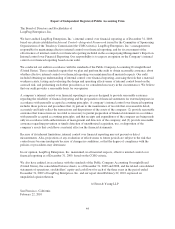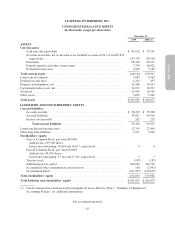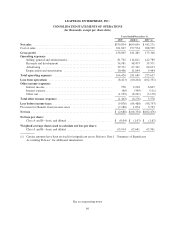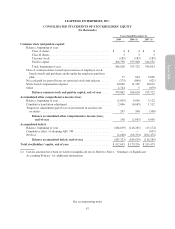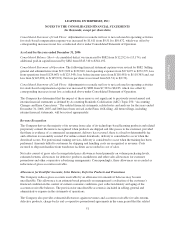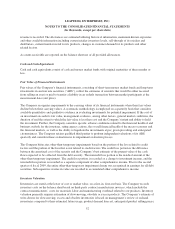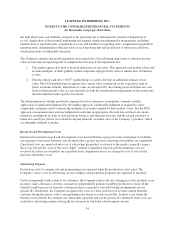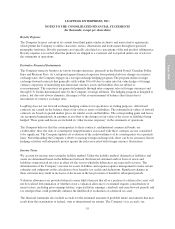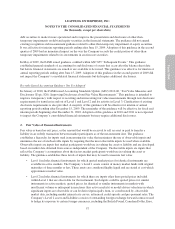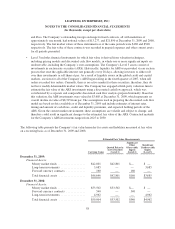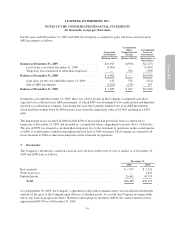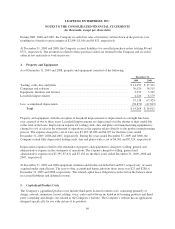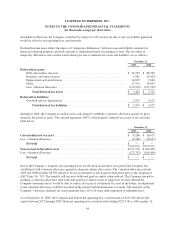LeapFrog 2009 Annual Report Download - page 64
Download and view the complete annual report
Please find page 64 of the 2009 LeapFrog annual report below. You can navigate through the pages in the report by either clicking on the pages listed below, or by using the keyword search tool below to find specific information within the annual report.LEAPFROG ENTERPRISES, INC.
NOTES TO THE CONSOLIDATED FINANCIAL STATEMENTS
(In thousands, except per share data)
the individual assets and liabilities assigned to the reporting unit to determine the amount of impairment to
record. Application of the goodwill impairment test requires significant judgment by management, including
identification of reporting units, assignment of assets and liabilities to reporting units, assignment of goodwill to
reporting units, determination of the fair value of each reporting unit and projections of future net cash flows,
which projections are inherently uncertain.
The Company considers the results generated from using both of the following approaches to estimate the fair
value of each relevant reporting unit to complete the first step of the impairment test:
1. The market approach is used to develop indications of fair value. This approach uses market values and
revenue multiples of other publicly traded companies engaged in the same or similar lines of business
as ours.
2. The discounted cash flow (“DCF”) methodology is used to develop an additional estimate of fair
value. The DCF methodology recognizes that current value is premised on the expected receipt of
future economic benefits. Indications of value are developed by discounting projected future net cash
flows to their present value at a rate that reflects both the current return requirements of the market and
the risks inherent in the specific investment.
The determination of whether goodwill is impaired involves numerous assumptions, estimates and the
application of significant judgment. For the market approach, considerable judgment is required to select
comparable companies and to estimate the multiples of revenues implied by their market values. For the DCF
approach, management must exercise judgment in selecting an appropriate discount rate and must also make
numerous assumptions in order to develop future business and financial forecasts and the related estimates of
future net cash flows. Future net cash flows depend primarily on future sales of the Company’s products, which
are inherently difficult to predict.
Research and Development Costs
Internal and external research and development costs incurred before a project reaches technological feasibility
are expensed as incurred. External costs incurred after a project reaches technological feasibility are capitalized.
Capitalized costs are amortized into cost of sales when the product is released to the market, generally using a
three-year life and the “sum of the years’ digits” method. Capitalized research and development costs are
reviewed for future recoverability on a quarterly basis. Impairment losses are charged to cost of sales in the
period in which they occur.
Advertising Expense
Production costs of commercials and programming are expensed when the production is first aired. The
Company’s direct costs of advertising, in-store displays and promotion programs are expensed as incurred.
Under arrangements with certain of its customers, the Company reduces the net selling price of its products as an
incentive (sales allowances) for the customers to independently promote LeapFrog products for resale. If the
benefits LeapFrog receives from the customer in these cooperative sales/advertising arrangements are not
specifically identifiable, the Company recognizes the costs as a direct reduction of revenue earned from the
customer during the period, with a corresponding reduction in accounts receivable. In those cases where the
benefits received from the customer are sufficiently separable and can be specifically identified, these costs are
included as advertising expense during the fiscal period in which the advertisements are run.
54


